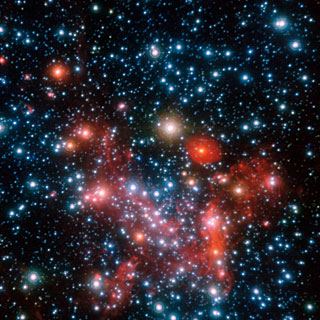







| BOOKS | F. A. Q. | ARTICLES | TALKS | ABOUT KEN | DONATE | BEYOND OUR KEN |
|---|
By Ken Croswell
Published on Science News (September 28, 2020)

This infrared image, which is 3.2 light-years across, shows the central
region of the massive cluster of stars at the Milky Way's core, about 27,000 light-years from Earth.
Credit: ESO, Stefan Gillessen et al.
The Milky Way's core harbors two giants: the Galaxy's largest black hole and a cluster of tens of millions of stars around the black hole that is denser and more massive than any other star cluster in the Galaxy.
Most of the cluster's many stars shine within just 20 light-years of the Galactic center and all together weigh about 25 million times as much as the Sun. New observations suggest that this "nuclear star cluster" owes some of its brilliance to another big group of stars, or even a small galaxy, that the main cluster swallowed.
Nuclear star clusters exist in many galaxies and are the densest star clusters in the universe. Astronomers are trying to figure out how these gatherings get so jam-packed and how they feed the giant black holes at the centers of galaxies.
To get a look at the Milky Way's core, Tuan Do, an astronomer at UCLA, and colleagues observed about 700 red giant stars within five light-years of the Galaxy's heart. Because dust between Earth and the Galactic center blocks the stars' visible light, the astronomers studied infrared wavelengths, which better penetrate the dust.
"We noticed a very curious thing about our data, which is that the stars with less metals than our Sun seem to be moving differently than the stars with more metals," Do says.
About 7 percent of the stars in the nuclear star cluster revolve around the Galactic center faster than their peers and do so around a different axis, the team found. The data on infrared wavelengths indicate that this fast-revolving population is only 30 percent as metal-rich as the Sun. In contrast, most of the other stars in the nuclear star cluster have more metals than the Sun.
"This discovery shows that at least some of our nuclear star cluster must have been formed from things falling in," Do says. A metal-poor star cluster thousands of light-years away from the Galactic core probably sank into the main star cluster, he and his colleagues report online September 28, 2020, in The Astrophysical Journal Letters.
Do says the infalling star cluster was the victim of dynamical friction, a process that can alter a star cluster's path through space. In this process, the orbiting star cluster's gravity attracts material that forms a wake behind it. The backward tug of this material's gravity then causes the cluster to plunge closer and closer to the Galactic center.
Scott Tremaine, an astrophysicist at the Institute for Advanced Study in Princeton, N.J., who was not involved in the work, calls the team's data on the nuclear cluster's stars unique. "I think by far the most natural explanation is that [the stars] do come from a cluster that's spiraled in," he says.
In a companion study, team member Manuel Arca Sedda at Heidelberg University in Germany and colleagues ran computer models to simulate how a star cluster falling into the Milky Way's nuclear star cluster could explain the new observations. These simulations indicate that such an event occurred less than 3 billion years ago, and that the devoured cluster was roughly a million times as massive as the Sun, the researchers report in a second study also published September 28 in The Astrophysical Journal Letters.
That mass is comparable to Omega Centauri, the Milky Way's most massive globular cluster, a type of star grouping that's dense but less extreme than nuclear star clusters. "It's definitely a lot," Do says. Just a dozen or so massive globular clusters could have populated the entire nuclear star cluster, he says.
Still, many of the nuclear star cluster's other stars may have been born in place at the Galactic center. And the scientists can't rule out that the gobbled-up victim was a dwarf galaxy. Both dwarf galaxies and globular clusters can possess a similar number of stars. But their stars have different ratios of chemical elements, so future observations of the nuclear star cluster may be able to distinguish between the two scenarios.
Ken Croswell earned his Ph.D. in astronomy from Harvard University and is the author of The Alchemy of the Heavens and The Lives of Stars.
"An engaging account of the continuing discovery of our Galaxy...wonderful." --Owen Gingerich, The New York Times Book Review. See all reviews of The Alchemy of the Heavens here.
"A stellar picture of what we know or guess about those distant lights."--Kirkus. See all reviews of The Lives of Stars here.
| BOOKS | F. A. Q. | ARTICLES | TALKS | ABOUT KEN | DONATE | BEYOND OUR KEN |
|---|